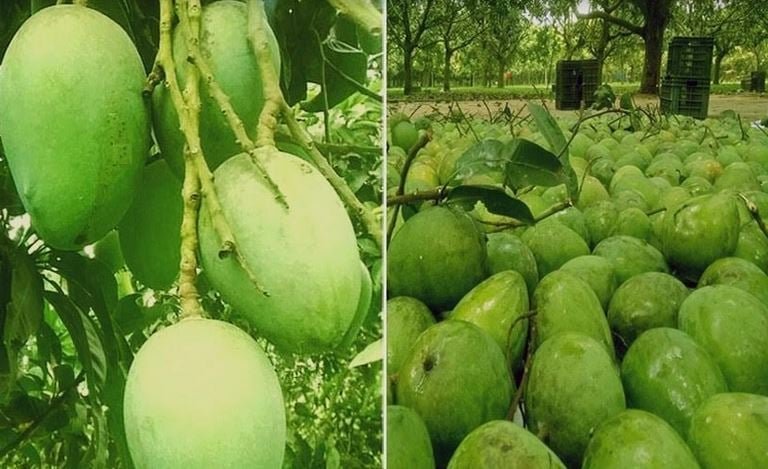BSS: A plentiful production of the fibreless, fleshy and highly tasty indigenous variety ‘Haribhanga’ mango is likely as its harvest has already begun with excellent yield in the district this season.
Officials of the Department of Agricultural Extension (DAE) here today predicted a plentiful output of medium-sized ‘Haribhanga’ mango this season due to less rainfall after the flowering and during the fruit formation stages.
“Harvest of ‘Haribhanga’ mango already began from June 10 last and the process will continue till July next,” said Deputy Director of the DAE for Rangpur Agriculturist Md. Obaidur Rahman Mandal.
Farmers have cultivated different varieties of mangoes in 3,535 hectares of land in the district, including ‘Haribhanga’ mangoes in 1,905 hectares of land, this year.
“We are expecting a production of 35,000 tonnes of ‘Haribhanga’ mango worth about Taka 250 crore this season,” Mondal added.
During the last season, farmers cultivated ‘Haribhanga’ mango in 1,865 hectares of land in all eight upazilas of Rangpur and achieved a bumper production to reap huge profits.
“Commercial basis cultivation of ‘Haribhanga’ mango that has huge demand in local markets is expanding every year in Rangpur and its adjoining areas bringing self-reliance to hundreds of farmers,” he said.
‘Haribhanga’ mango is mostly being cultivated in the orchards in Akhirarhat, Khoragachh, Podaganj, Matherhat, Rangatipara, Bangaon, Paikarerhat, Rukniganj, Tekani, Moyenpur, Kadamtala, Lalpukur, Shukurerhat, Shikarpur, Phulchowki, Tilakpara, Kashimpur, Ucha Balua and many other villages in Mithapukur upazila of Rangpur.
The mango is largely being cultivated on commercial basis in dozens of villages under all other seven upazilas of Rangpur and other places of Gaibandha, Kurigram, Lalmonirhat and Nilphamari districts under Rangpur agriculture region.
“Besides, cultivation of ‘Haribhanga’ mango is expanding fast in Parbatipur, Nababganj, Fulbari, Khansama, Birampur and Chirirbandar upazilas of Dinajpur and many other areas all over Rangpur division,” Mondal added.
Market sources said the per kg price of ‘Haribhanga’ mango currently remains between Taka 40 and 55 depending on the size and quantity with a possibility of price rise in the coming weeks.
“The price of ‘Haribhanga’ mango might go up to 300 to 400 per kg at the end of the harvesting season in the last week of July next,” said fruit trader at Rangpur City Bazar Babu Mian today.
Despite huge sales of ‘Haribhanga’ mango in local markets, many youths of Rangpur city and Mithapukur upazila have become engaged in online marketing to reach the tasty fruit to people across the country through courier services.
Youth Sarkar Manjurul Mannan, an online mango supplier, said he has been taking orders online and delivering ‘Haribhanga’ mango to customers of different parts across the country.
“I have received plenty of orders for supplying ‘Haribhanga’ mango since June 10, the first day of the harvesting season,” he said.
“So far, we have taken orders at rates between Taka 1,400 and Taka 2,000 per mound (every 40 kgs) depending on the size of the mangoes,” he said.
The cost of sending ‘Haribhanga’ mango to Dhaka is Taka 1,000 including costs for carriage, packing and courier services and Taka 1,200 for sending outside Dhaka.
‘Haribhanga’ mango growers Nafal Uddin Paikar, Abdus Salam, Amjad Hossain, Shajahan Mian, Hasan Mian, Nazrul Islam and Ansar Ali of Mithapukur upazila in Rangpur predicted a super bumper production of the mango this season.

